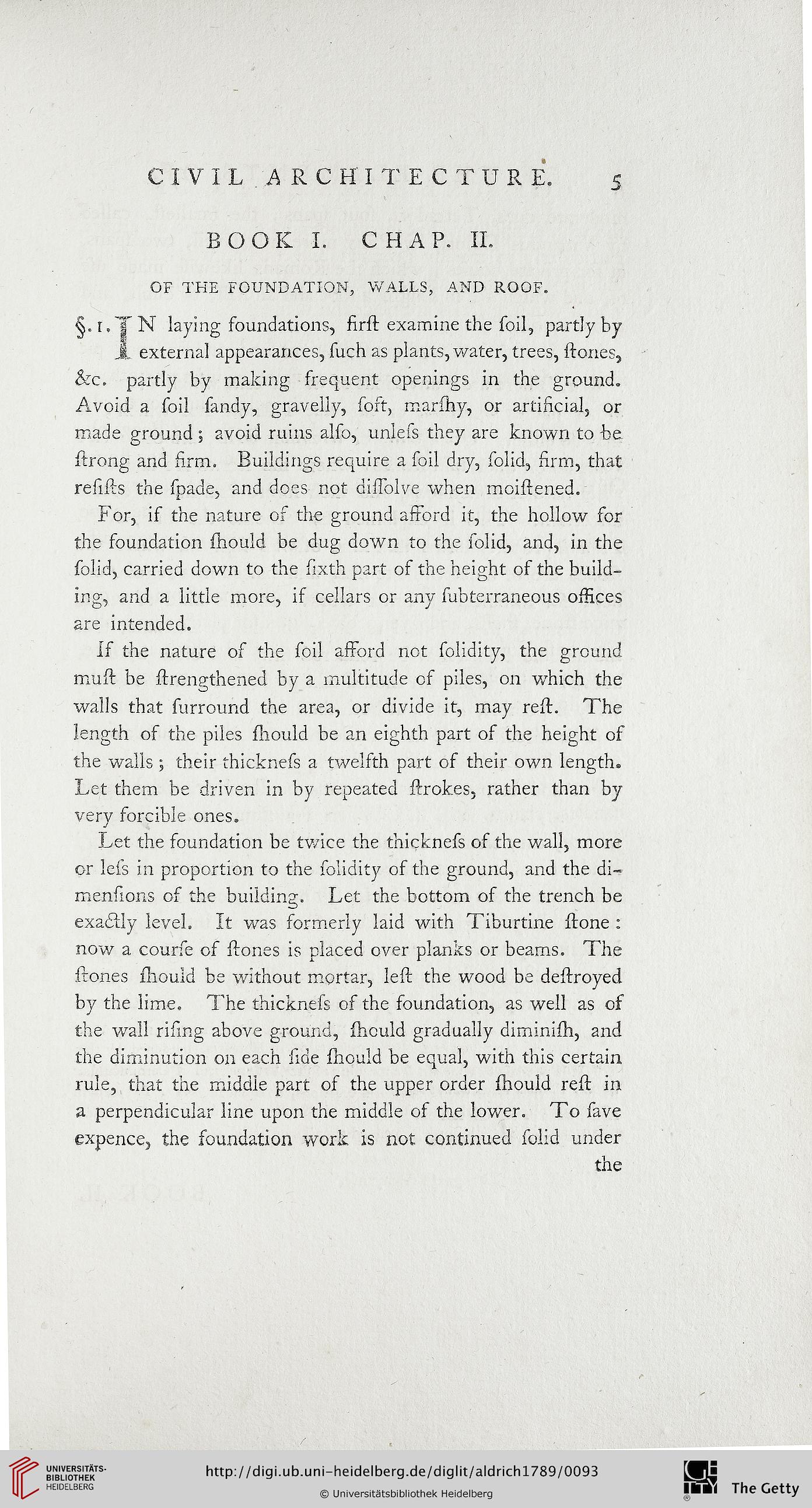CIVIL ARCHITECTURE.
5
BOOK I. CHAP. IL
OF THE FOUNDATION, WALLS, AND ROOF.
§. r.T N laying foundations, first examine the soil, partly by
A external appearances, such as plants, water, trees, Hones,
&c. partly by making frequent openings in the ground.
Avoid a soil sandy, gravelly, sort, marshy, or artificial, or
made ground ; avoid ruins also, unless they are known to be
strong and firm. Buildings require a soil dry, solid, firm, that
resills the spade, and does not dissolve when moistened.
For, is the nature os the ground afford it, the hollow for
the foundation should be dug down to the solid, and, in the
solid, carried down to the sixth part of the height of the build-
ing, and a little more, if cellars or any subterraneous offices
are intended.
If the nature os the soil afford not solidity, the ground
muss be {Lengthened by a multitude of piles, on which the
walls that surround the area, or divide it, may rest. The
length of the piles should be an eighth part of the height of
the walls ; their thickness a twelfth part of their own length.
Let them be driven in by repeated strokes, rather than by
very forcible ones.
Let the foundation be twice the thickness of the wall, more
or less in proportion to the solidity of the ground, and the di-
mensions of the building. Let the bottom of the trench be
exactly level. It was formerly laid with Tiburtine st one :
now a course of stones is placed over planks or beams. The
Hones should be without mortar, lest the wood be destroyed
by the lime. The thickness of the foundation, as well as of
the wall rising above ground, shculd gradually diminish, and
the diminution on each side should be equal, with this certain
rule, that the middle part of the upper order should rest in
a perpendicular line upon the middle of the lower. To save
expence, the foundation work is not continued solid under
the
5
BOOK I. CHAP. IL
OF THE FOUNDATION, WALLS, AND ROOF.
§. r.T N laying foundations, first examine the soil, partly by
A external appearances, such as plants, water, trees, Hones,
&c. partly by making frequent openings in the ground.
Avoid a soil sandy, gravelly, sort, marshy, or artificial, or
made ground ; avoid ruins also, unless they are known to be
strong and firm. Buildings require a soil dry, solid, firm, that
resills the spade, and does not dissolve when moistened.
For, is the nature os the ground afford it, the hollow for
the foundation should be dug down to the solid, and, in the
solid, carried down to the sixth part of the height of the build-
ing, and a little more, if cellars or any subterraneous offices
are intended.
If the nature os the soil afford not solidity, the ground
muss be {Lengthened by a multitude of piles, on which the
walls that surround the area, or divide it, may rest. The
length of the piles should be an eighth part of the height of
the walls ; their thickness a twelfth part of their own length.
Let them be driven in by repeated strokes, rather than by
very forcible ones.
Let the foundation be twice the thickness of the wall, more
or less in proportion to the solidity of the ground, and the di-
mensions of the building. Let the bottom of the trench be
exactly level. It was formerly laid with Tiburtine st one :
now a course of stones is placed over planks or beams. The
Hones should be without mortar, lest the wood be destroyed
by the lime. The thickness of the foundation, as well as of
the wall rising above ground, shculd gradually diminish, and
the diminution on each side should be equal, with this certain
rule, that the middle part of the upper order should rest in
a perpendicular line upon the middle of the lower. To save
expence, the foundation work is not continued solid under
the





